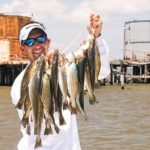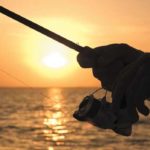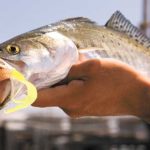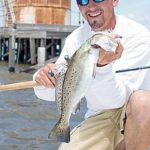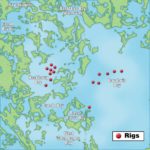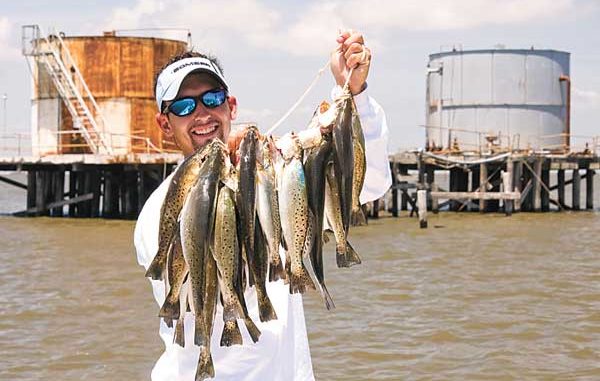
Beat the crowds out of the Lafitte docks, and you’ll beat them back with a box full of specks.
The summer trout bite happens quickly in Barataria Bay. Spend too much time at the coffee pot, and your chances of putting up big numbers goes down with every stir of your spoon. Be on them when the sun comes up, though, and you have two, maybe two and a half hours to put trout in the boat.Put your coffee in a Thermos, and go.
Getting there early is only half of the equation. Picking the wrong spot is just as bad as leaving late; both cost you precious minutes that tick away all too quickly.
You want to catch trout out of Lafitte this summer? Get to the right spot early.
Leaving the dock an hour before sunrise is easy as long as you have the will power to shove the sausage away. Picking the right spot isn’t quite so easy. With hundreds of points, flocks of birds and miles of oyster reefs, finding fish can feel like hunting the proverbial needle in a haystack. And in the Barataria system, there are a lot of really small needles.
There is a way you can increase your chances of being in the right spot at sunrise. By setting up shop on one of the shallow rigs in Barataria Bay or nearby Hackberry Bay, not only will the likelihood of being in the right spot increase, so will the size of your fish.
“People usually aren’t coming to Barataria to fish the rigs,” said Capt. Chris Pike with Bourgeois Charters. “Most don’t fish them, and they’re an underused structure around here. Guys like to fish the islands and chase birds all day, but they pass up a lot of good fishing when they pass the rigs.”
Aside from these shallow rigs congregating schools of large (a relative term around Lafitte) trout, they are really easy to get to. After traveling the Barataria Waterway through Mud Lake, the water narrows back down before it opens up into the north side of Barataria Bay around Cabanash Cove.
At this point, the Barataria rigs are visible to the east and the Hackberry rigs are visible to the west. Given his druthers, Pike would turn to the west and fish the Hackberry rigs.
“The rigs fish the same, but the difference is that Hackberry Bay usually has cleaner water, and it gets a lot less fishing pressure,” he said. “Hackberry also has more rigs to fish, and, even on the weekends, you won’t have too many boats around you at all.”
When these rigs were constructed, Capt. C.J. Rojas with Rojas Charters says piles of clamshells were piled up on the bottom upon which barges were parked. Pilings were then built up around the barges.
Now, the combination of shells and pilings work together to create little ecosystems that provide everything larger trout prefer.
“The ones that still have the shell pads around them are the best rigs,” Rojas said. “The rigs are good enough structures themselves, but the clam shells definitely don’t hurt. The pilings hold barnacles and the shells hold bait. Of course, the trout are there to eat the bait.”
Pike has found over the years that the north sides of many of these shallow rigs are more productive than the other sides. What he has discovered is that it is the north sides that have the best shell pads. That’s not to say you can’t catch trout all around the rigs, but Pike says he definitely hits the north side of each rig first when he’s looking.
“An incoming tide is best for fishing the north sides of the rigs,” he explained. “The fish stack up on those shells and look back at the rig — they’re waiting on bait to come through the legs of the rig. I like to quickly fish from the northeast corner to the northwest corner by casting up to the rig and working my bait back over the shells.”
When the tide reverses and starts falling out, the best fishing moves to the opposite side of the rigs. Although Pike has found that the south ends aren’t as productive, he still moves to that side on a falling tide to take advantage of the ambush situation created by the tide pulling bait through the rigs.
Although playing the tide is important, none of these rigs is so large that you couldn’t just quickly drop your trolling motor and circle each of them until you find where the trout are positioned. In fact, that’s how Rojas typically attacks a rig.
“I like to fish each rig based on the current and wind,” he said. “But it’s really a trial-and-error thing every day. That’s why I usually circle the rigs and hit all sides just to make sure we’re not leaving anything behind.”
These rigs may not be in the deep water like the rigs out in Breton Sound or around the mouth of the Mississippi River, but they fish almost identically. Live bait works wonders under a cork or on the bottom, but plastics aren’t far behind.
Rojas, a self-admitted student of the old school, says a lot of baits work out there on the rigs, but he most frequently relies on sparkle beetles fished under corks. He’s not averse to throwing new stuff, though, so he sometimes tries Cocahoes and some of the YUM saltwater soft plastics.
Pike likes fishing under popping corks, too, but he bases his bait selection more on the wind than anything else. On a good, calm day with a tidal range over 1 foot, Pike throws opening night or black/chartreuse plastics under the cork. Wind-driven ripple forces him to change over to live bait, which he soaks on the bottom with a Carolina rig.
“You can also fish some of the new swim baits when the wind picks up,” he added. “Any of the cocaho tails work well tightlined over the shell pads, but I’m looking forward to seeing if I can up my size a little bit by throwing that YUM Money Minnow this year.”
Pike says that if you pinpoint your rigs and find five or six that are really on, a good day on the rigs would be about 25 to 30 keepers around 14 inches with just a few throwbacks. These aren’t your typically Lafitte trout that feed under the birds.
“I think the bigger fish prefer getting around the structure more so than they do following the bait under the birds,” Pike said. “Bigger trout are more ambush-oriented, and that’s exactly the situation they get on the rigs.”
Since the rigs aren’t very large, Pike and Rojas like to troll around the rigs rather than having to drop and retrieve their anchors every time they want to move. Deploying an anchor so many times in 5 feet of water wouldn’t be an ideal situation anyway, and it might lead to shutting down the bite.
If Pike gets on a good school of fish, he may consider quietly dropping an anchor, but he says that tying off to the rig is probably the best way to go as long as it will put you in the right position.
Although trout started showing up on the rigs back in April, Pike passed along that June through August would be the best months to fish them. These bays should be loaded with shrimp and baitfish during those months, and the rigs will draw in lots of things that trout like to eat.
“And I wouldn’t fish the rigs if the tide range was less than 1 foot,” Pike said. “If that’s the case, go chase birds. You can also get too much tide for the rigs. Anything over 2 feet you’re going to have too much water moving. You may still catch fish, but I would expect the number of fish you catch at each rig to drop to maybe three or four.”
Rigs are awesome places to catch speckled trout no matter where they are. It just so happens that the rigs in Barataria Bay and Hackberry Bay don’t get near the attention they deserve. Just remember that you’ve got to get there early to get in on the action.
Father’s Day is coming up this month. If you fish out of Lafitte, it might be a good time to ask for a Thermos. U
Contact Capt. Chris Pike at (504-341-5614) or www.neworleansfishing.com. Contact Capt. C.J. Rojas at (504-233-1005) or www.rojascharters.com. Follow the author’s blog at www.chrisginn.com.
